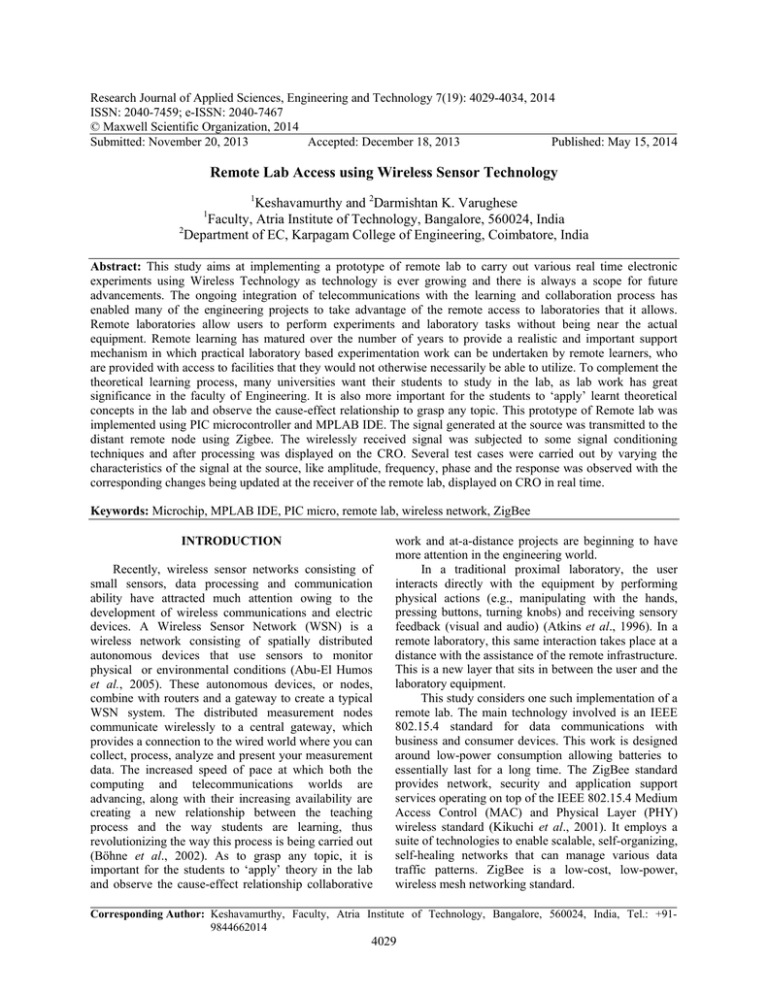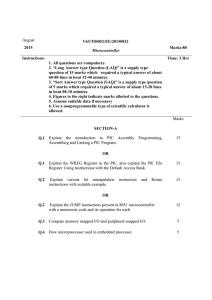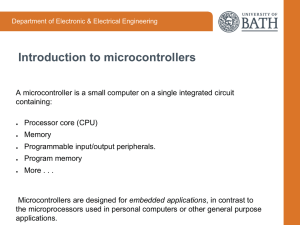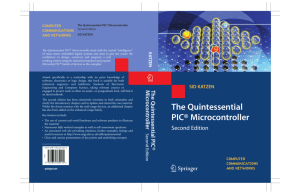Research Journal of Applied Sciences, Engineering and Technology 7(19): 4029-4034,... ISSN: 2040-7459; e-ISSN: 2040-7467
advertisement

Research Journal of Applied Sciences, Engineering and Technology 7(19): 4029-4034, 2014 ISSN: 2040-7459; e-ISSN: 2040-7467 © Maxwell Scientific Organization, 2014 Submitted: November 20, 2013 Accepted: December 18, 2013 Published: May 15, 2014 Remote Lab Access using Wireless Sensor Technology 1 Keshavamurthy and 2Darmishtan K. Varughese Faculty, Atria Institute of Technology, Bangalore, 560024, India 2 Department of EC, Karpagam College of Engineering, Coimbatore, India 1 Abstract: This study aims at implementing a prototype of remote lab to carry out various real time electronic experiments using Wireless Technology as technology is ever growing and there is always a scope for future advancements. The ongoing integration of telecommunications with the learning and collaboration process has enabled many of the engineering projects to take advantage of the remote access to laboratories that it allows. Remote laboratories allow users to perform experiments and laboratory tasks without being near the actual equipment. Remote learning has matured over the number of years to provide a realistic and important support mechanism in which practical laboratory based experimentation work can be undertaken by remote learners, who are provided with access to facilities that they would not otherwise necessarily be able to utilize. To complement the theoretical learning process, many universities want their students to study in the lab, as lab work has great significance in the faculty of Engineering. It is also more important for the students to ‘apply’ learnt theoretical concepts in the lab and observe the cause-effect relationship to grasp any topic. This prototype of Remote lab was implemented using PIC microcontroller and MPLAB IDE. The signal generated at the source was transmitted to the distant remote node using Zigbee. The wirelessly received signal was subjected to some signal conditioning techniques and after processing was displayed on the CRO. Several test cases were carried out by varying the characteristics of the signal at the source, like amplitude, frequency, phase and the response was observed with the corresponding changes being updated at the receiver of the remote lab, displayed on CRO in real time. Keywords: Microchip, MPLAB IDE, PIC micro, remote lab, wireless network, ZigBee INTRODUCTION Recently, wireless sensor networks consisting of small sensors, data processing and communication ability have attracted much attention owing to the development of wireless communications and electric devices. A Wireless Sensor Network (WSN) is a wireless network consisting of spatially distributed autonomous devices that use sensors to monitor physical or environmental conditions (Abu-El Humos et al., 2005). These autonomous devices, or nodes, combine with routers and a gateway to create a typical WSN system. The distributed measurement nodes communicate wirelessly to a central gateway, which provides a connection to the wired world where you can collect, process, analyze and present your measurement data. The increased speed of pace at which both the computing and telecommunications worlds are advancing, along with their increasing availability are creating a new relationship between the teaching process and the way students are learning, thus revolutionizing the way this process is being carried out (Böhne et al., 2002). As to grasp any topic, it is important for the students to ‘apply’ theory in the lab and observe the cause-effect relationship collaborative work and at-a-distance projects are beginning to have more attention in the engineering world. In a traditional proximal laboratory, the user interacts directly with the equipment by performing physical actions (e.g., manipulating with the hands, pressing buttons, turning knobs) and receiving sensory feedback (visual and audio) (Atkins et al., 1996). In a remote laboratory, this same interaction takes place at a distance with the assistance of the remote infrastructure. This is a new layer that sits in between the user and the laboratory equipment. This study considers one such implementation of a remote lab. The main technology involved is an IEEE 802.15.4 standard for data communications with business and consumer devices. This work is designed around low-power consumption allowing batteries to essentially last for a long time. The ZigBee standard provides network, security and application support services operating on top of the IEEE 802.15.4 Medium Access Control (MAC) and Physical Layer (PHY) wireless standard (Kikuchi et al., 2001). It employs a suite of technologies to enable scalable, self-organizing, self-healing networks that can manage various data traffic patterns. ZigBee is a low-cost, low-power, wireless mesh networking standard. Corresponding Author: Keshavamurthy, Faculty, Atria Institute of Technology, Bangalore, 560024, India, Tel.: +919844662014 4029 Res. J. App. Sci. Eng. Technol., 7(19): 4029-4034, 2014 ELECTRONIC REMOTE LAB The main task of this study is the development of a possibility to do measurement on electronic circuits from anywhere in the lab via Wireless Technology. Access to information has been facilitated due to the developments in communication technologies. These experiments are carried out by means of remote controlled real laboratory instruments and are not simulated in order to offer realistic lab situation (Michael, 2008). For instance, single CRO can be used to view the output result of two Electronic circuits used by two distant users within a lab using Wireless Technology Two CRO’s can be replaced by a single CRO. Hence cost effective. The system is designed using intelligent embedded PIC 18F452 from Microchip Technology. Recent developments in distance education have brought about the issue of holding sessions with students in different locations. It is possible to improve quality of education and decrease cost of education by increasing the number of student benefiting. Remote labs give students the opportunity to work in the remote mode, which will eventually become important in Engineering Jobs (Bonatti et al., 2005). Remote labs provide extended access to expensive and high specialized devices. Unlike simulation Remote labs provide real lab experience. Fig. 1: Remote lab access transmitter DESIGN OF REMOTE LAB The various blocks of the implemented remote lab prototype are shown in the Fig. 1. Both the transmitter and the receiver are implemented using PIC 18F452 micro controller ICs and RS232. Reset: Reset is used for putting the microcontroller into a 'known' condition. That practically means that microcontroller can behave rather inaccurately under certain undesirable conditions. In order to continue its proper functioning it has to be reset, meaning all registers would be placed in a starting position. Reset is not only used when microcontroller doesn't behave the way we want it to, but can also be used when trying out a device as an interrupt in program execution, or to get a microcontroller ready when loading a program. Oscillator: One major disadvantage of using Pic micro controller is it doesn’t have an internal clock generator circuit. An external crystal oscillator of 4 MHz is been used to trigger the pic micro controller. Pin no. 13 and 14 is used to give clock input and clock output, respectively. Frequency generator: The input digital frequency signal which we need to transmit is given to the Pic micro controller. The ports in Pic micro controller can Fig. 2: Remote lab access receiver be used as both input and output. The interrupt port pin RB0 is used to give the input signal and also to draw the output. The Pic micro controller is been programmed in such a way that 0 v input signal is been coded as logic 0 and 5 v input signal is been coded as logic 1. RS 232: RS232 a DB9 connector which is a serial port communication channel acts as a connecting device between the Pic micro controllers and the ZigBee. It’s a communication channel which converts TTL logic 5 v of Pic micro controller to 12 V which is required to drive Zigbee. MAX232 is used to conversion of 5 v to 1 2 v. For pumping the voltage to 12 v capacitors are been used with this. It can transmit data up to 4 Km Liquid crystal display: LCD displays utilize two sheets of polarizing material with a liquid crystal solution between them. The data is displayed on a 16Χ2 LCD corresponding to the programming done in the PIC 18F452 on the receiver side. LCD has been to designed in 4 bit mode, where first 4 bits are grounded and last 4 bits are configured port A is been used to drive LCD with an array of pull up resistors and the electronic remote lab receiver is shown in Fig. 2. 4030 Res. J. App. Sci. Eng. Technol., 7(19): 4029-4034, 2014 HARDWARE DESIGN This section discusses the various hardware components used for implementing the remote lab using wireless technology. PIC microcontroller: A PIC microcontroller is an amazingly powerful fully featured processor with internal RAM, EEROM FLASH memory and peripherals. One of the smallest ones occupies the space of a 555 timer but has a 10 bit ADC, 1k of memory, 2 timers, high current I/O ports a comparator a watch dog timer so on. One of the most useful features of a PIC microcontroller is that you can re-program them as they use flash memory. PIC can also use the ICSP serial interface built into each PIC Microcontroller for programming and even do programming while it's still plugged into circuit (Gibson and Liu, 1980). PIC microcontrollers (18FXXX series) have attractive features and they are suitable for a wide range of applications. PIC microcontrollers are RISC processors and uses Harvard architecture. It is a newer concept and came out of the requirements to speed-up the processor. Harvard architecture makes use of separate program and data memories. PIC 18FXXX is a family of CMOS 8-bit Flash controllers. Apart from the flash program memory there is a data EEPROM. Zigbee: ZigBee is an IEEE 802.15.4 standard for data communications with business and consumer devices. It is designed around low-power consumption allowing batteries to essentially last forever. The ZigBee standard provides network, security and application support services operating on top of the IEEE 802.15.4 Medium Access Control (MAC) and Physical Layer (PHY) wireless standard. It employs a suite of technologies to enable scalable, self-organizing, selfhealing networks that can manage various data traffic patterns. ZigBee is a low-cost, low-power, wireless mesh networking standard. The low cost allows the technology to be widely deployed in wireless control and monitoring applications, the low power-usage allows longer life with smaller batteries and the mesh networking provides high reliability and larger range. ZigBee has been developed to meet the growing demand for capable wireless networking between numerous low power devices (Hoyer et al., 2004). Zigbee features and characteristics: The focus of network applications under the IEEE 802.15.4/ZigBee standard include the features of low power consumption, needed for only two major modes (Tx/Rx or Sleep), high density of nodes per network, low costs and simple implementation. ZigBee-compliant products operate in unlicensed bands worldwide, including 2.4 GHz (global), 902 to 928 MHz (Americas) and 868 MHz (Europe). Raw data throughput rates of 250 Kbps Fig. 3: UART data packet 0x1F (decimal number ʺ31ʺ) as transmitted through the RF module can be achieved at 2.4 GHz (16 channels), 40 Kbps at 915 MHz (10 channels) and 20 Kbps at 868 MHz (1 channel). The transmission distance is expected to range from 10 to 75 m, depending on power output and environmental characteristics. Like Wi-Fi, Zigbee uses direct-sequence spread spectrum in the 2.4 GHz band, (Paladini et al., 2008) with offset-quadrature phaseshift keying modulation. Channel width is 2 with 5 MHz channel spacing. The 868 and 900 MHz bands also use direct-sequence spread spectrum but with binary-phase-shift keying modulation. RF module operation: Serial Data Devices that have a UART interface can connect directly to the pins of the RF module. The XBeeZNet 2.5 OEM RF Modules interface to a host device through a logic-level asynchronous serial port. Through its serial port, the module can communicate with any logic and voltage compatible UART or through a level translator to any serial. Data enters the module UART through the DIN (pin 3) as an asynchronous serial signal. The signal should idle high when no data is being transmitted. Each data byte consists of a start bit (low), 8 data bits (least significant bit first) and a stop bit (high). The Figure 3 illustrates the serial bit pattern of data passing through the module. Modes of operation: Idle mode: When not receiving or transmitting data, the RF module is in Idle Mode. During Idle Mode, the RF module is also checking for valid RF data. The module shifts into the other modes of operation under the following conditions: • • • • Transmit Mode (Serial data in the serial receive buffer is ready to be packetized) Receive Mode (Valid RF data is received through the antenna) Sleep Mode (End Devices only) Command Mode (Command Mode Sequence is issued) Transmit mode: When serial data is received and is ready for packetization, the RF module will exit Idle 4031 Res. J. App. Sci. Eng. Technol., 7(19): 4029-4034, 2014 Mode and attempt to transmit the data. The destination address determines which node (s) will receive the data. Prior to transmitting the data, the module ensures that a 16-bit network address and route to the destination node have been established (William, 2004). If the destination 16-bit network address is not known, network address discovery will take place. If a route is not known, route discovery will take place for the purpose of establishing a route to the destination node. If a module with a matching network address is not discovered, the packet is discarded. The data will be transmitted once a route is established. If route discovery fails to establish a route, the packet will be discarded (Travis, 2005). When data is transmitted from one node to another, a network-level acknowledgement is transmitted back across the established route to the source node. This acknowledgement packet indicates to the source node that the data packet was received by the destination node. If a network acknowledgement is not received, the source node will re-transmit the data. It is possible in rare circumstances for the destination to receive a data packet, but for the source to not receive the network acknowledgment. In this case, the source will retransmit the data, which could cause the destination to receive the same data packet multiple times. The XBeeZNet 2.5 modules do not filter out duplicate packets. The application should include provisions to address this potential issue See Data Transmission and Routing in chapter 3 for more information. START ALL INITIALISATION START TIMER IF TIMER IS > 1SEC No Yes STOP TIMER TRANSMIT SERIALLY FREQUENCY VALUE RECEIVE AND COUNT PULSES Fig. 4: Transmitter side flow chart SOFTWARE DESIGN OF REMOTE LAB The software design for implementing the Electronic Remote Lab is shown in this section. The software was developed in C/Assembly using MPLAB IDE. Flow chart for transmitter: At the transmitter side we program the PIC micro controller by first initializing the PIC by a timer program with 1 sec delay. Figure 4 shows the flow chart of the transmitter. A counter program is used to set the delay and to count the number of input pulses. Serial port program is used for serial communication between PIC and Zigbee module which is burnt on to the PIC micro controller. Flow chart for receiver: At the receiver side we program the PIC micro controller by first initializing the PIC by a timer program with 50 m sec delay. The received signal was subjected to some signal conditioning techniques and after processing was displayed on the CRO. Several test cases were carried out by varying the characteristics of the signal at the source, like amplitude, frequency, phase and the response was observed with the corresponding changes being updated at the receiver of the remote lab, displayed on CRO in real time. Serial port program is used for serial communication between PIC and ZigBee Fig. 5: Receiver side flow chart module which is burnt on to the PIC micro controller. Figure 5 shows the flow chart of the transmitter. IDE MPLAB from microchip: MPLAB X IDE (20112012) is a software program that runs on a PC to develop applications for Microchip microcontrollers and digital signal controllers. It is called an Integrated Development Environment (IDE), because it provides a single integrated “environment” to develop code for embedded microcontrollers (Microchip Technology Inc., 2011-2012). The peripherals and the amount of memory an application needs to run a program largely determines which PIC micro MCU to use. A development system for embedded controllers is a system of programs running on a desktop PC to help write, edits, debug and program code. Once the code builds with no errors, it needs to be tested. MPLAB IDE has components called 4032 Res. J. App. Sci. Eng. Technol., 7(19): 4029-4034, 2014 CRO and by varying the characteristics of the signal at the source, like amplitude, frequency, phase and the response was observed with the corresponding changes being updated at the receiver of the remote lab, displayed on CRO in real time. The signal transmitted is received through the receiver side of the model as shown in Fig. 8 and finally the input and output signals are tested and observed in cathode ray oscilloscope. Fig. 6: LCD display CONCLUSION The large majority of the courses on Science and Technology areas where lab work is a fundamental part of the apprenticeship were not until recently available to be taught at distance (Javier et al., 2008). This reality is changing with the dissemination of remote laboratories. Supported by resources based on new information and communication technologies, it is now possible to remotely control a wide variety of real laboratories. In this study, an alternative remote lab infrastructure devoted to the study of electronics is presented. Its main characteristics are, from a teacher’s perspective, reusability and simplicity of use, low-cost, low-power and from a student’s point of view, an exact replication of the real lab, enabling them to complement or finish at home the work they had done while in class. The remote laboratory is integrated in the Learning Management System in use at the school and therefore may be combined with other web experiments and e-learning strategies, while addressing security access issues. Fig. 7: Transmitter side of the model Fig. 8: Receiver side of the model “debuggers” and free software simulators for all PICmicro and dsPIC devices to help test the code. Even if the hardware is not yet finished, we can begin testing the code with the simulator, a software program that simulates the execution of the microcontroller. The MPLAB ICD 2 uses special circuitry built into many Microchip MCUs with Flash program memory and can “see into” the target microcontroller’s program and data memory. The MPLAB ICD 2 can stop and start program execution, allowing you to test the code with the microcontroller in place on the application. RESULTS AND DISCUSSION The experiment conducted in the electronics lab with real lab equipment’s is done using remote lab using wireless network technology. The input frequency is generated by signal source and it is displayed on the LCD shown in Fig. 6 and output frequencies also tested and observed in LCD display. The microcontroller and Zigbee transmitter is interfaced as shown in Fig. 7. The wirelessly received signal was subjected to some signal conditioning techniques and after processing was displayed on the REFERENCES Abu-El Humos, A., B. Alhalabi, M.K. Hamzal, E. Shufro and W. Awada, 2005. Remote Labs Environments (RLE): A constructivist online experimentation in science, engineering and information technology. Proceeding of the 31st Annual Conference of the IEEE Industrial Electronics Society, Sheraton Capital Center, Raleigh, North Carolina, USA, ISBN: 0-78039252-3. Atkins, B., C.A. Bohus, L.A. Crowl and M.H. Shor, 1996. Distance learning applied to control engineering laboratories. IEEE T. Educ., 39: 320-326. Böhne, A., N. Faltin and B. Wagner, 2002. Selfdirected learning and tutorial assistance in a remote laboratory. Proceeding of the Interactive Computer Aided Learning Conference (ICL’2002). Villach, Austria. Bonatti, D., G. Pasini, L. Peretto and R. Tinarelli, 2005. An interactive measurement system for remote laboratory activities. Proceeding of the 22nd IEEE Instrumentation and Measurement Technology Conference (IMTC/05), pp: 2107-2112. 4033 Res. J. App. Sci. Eng. Technol., 7(19): 4029-4034, 2014 Gibson, G. and Y. Liu, 1980. Microcomputers for Engineers and Scientists. Prentice-Hall, Englewood Cliffs. Hoyer, H., A. Jochheim, C. Rohrig and A. Bischoff, 2004. A multiuser virtual-reality environment for a tele-operated laboratory. IEEE T. Educ., 47(1): 121-126. Javier, G.Z., D. López-de-Ipiña and P. Orduña, 2008. Mobile devices and remote labs in engineering education. Proceeding of the 8th IEEE International Conference on Advanced Learning Technologies, pp: 620-622. Kikuchi, T., T. Kenjo and S. Fukuda, 2001. Remote laboratory for Brushless dc motor. IEEE T. Educ., 44: 243-256. Michael, E.A., 2008. Virtual Lab versus Remote Lab. Carinthia Tech Institute, School of Electronics, University of Applied Sciences, Austria. Microchip Technology Inc., 2011-2012. MPLAB X IDE, User’s Guide. ISBN: 978-1-62076-605-7. MPLAB X IDE, 2011-2012. User’s Guide Microchip Technology Inc. ISBN: 978-1-62076-605-7. Paladini, S., J.B. Da Silva, G.R. Alves, B.R. Fischer and J.B. Da Mota Alves, 2008. Using remote lab networks to provide support to public secondary school education level. Proceeding of the 11th IEEE International Conference on Computational Science and Engineering-Workshops, pp: 275-280. Travis, J., 2005. Internet Applications in Lab VIEW. Prentice Hall PTR, Upper Saddle River, NJ. William, S., 2004. Wireless Communication and Networks. 4th Edn., Pearson Publication Ltd., pp: 39-118. 4034





